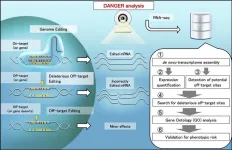(Press-News.org) (COLUMBUS, Ohio) – In most people, every cell in their body contains the same genetic information. However, sometimes people can have two or more genetically different sets of cells. This usually happens during fetal development and is known as mosaicism. Sometimes one of those groups of cells has genetic changes that can cause diseases or disorders.
Neurologists, neurosurgeons and genomics experts have been working together to test for mosaicism in brain tissues resected during epilepsy surgery. Research has shown that mosaicism in the brain is a significant contributor to epilepsy.
In a new study, recently published in Nature Genetics, researchers from Nationwide Children’s Hospital describe an alternate origin of brain mosaicism in some children with focal epilepsy.
“About 1 in every 26 people will have epilepsy at some point in their lives. The causes are incredibly diverse, and a mystery in over half of people with epilepsy,” says Adam Ostendorf, MD, a pediatric neurologist at Nationwide Children’s and an author of the study.
About a third of children with epilepsy have drug-resistant seizures that greatly affect their quality of life, safety and developmental outcomes. “We were motivated to study the genetic causes of drug-resistant epilepsy so future research might be able to develop more effective treatments,” says Tracy Bedrosian, PhD, senior author of the paper and principal investigator in the Steve and Cindy Rasmussen Institute for Genomic Medicine at Nationwide Children’s Hospital.
The researchers performed a genetic analysis of brain tissue, blood and buccal (epithelial) cells. Tissue samples were from six patients, ages 2 months to 7 months, who underwent epilepsy surgery. The brain samples showed that some of the cells in the brain tissue (including astrocytes) had extra copies of chromosome 1q compared to the normal tissue. The blood and buccal cells did not have any cells with extra copies.
Notably, astrocytes carrying the extra 1q showed distinct gene expression signatures and histopathologic differences such as hyaline inclusions. This evidence supports the association of chromosome 1q gains with astrocytic inclusions in epilepsy.
“From a practical standpoint, in neurosurgical cases of focal epilepsy where we see certain histopathological signs, namely hyaline astrocytic inclusions, we can suspect the underlying genetic etiology is chromosome 1q gain,” says Dr. Bedrosian, who is also an assistant professor of Pediatrics at The Ohio State University College of Medicine.
But that etiology wasn’t the only finding in the study.
“The surprising finding was that the genetic alteration (chromosome 1q gains) was inherited in some of the patients, even though it was only found in a mosaic pattern within brain tissue,” Dr. Bedrosian adds. “This finding was a serendipitous observation that led us down a path to discover a novel mechanism for brain mosaicism.”
Analysis indicated that in five of the six patients, the extra chromosome copies were maternally derived – that is, they were present as a result of an error in the meiotic divisions that formed the egg. The analysis demonstrates that this error was corrected (rescued) by cell repair mechanisms during embryonic or fetal development in most tissues (blood and buccal) but not in all brain cells.
Katherine Miller, PhD, first author of the study and principal investigator in the Institute for Genomic Medicine, notes the uniqueness of the finding.
“We were able to genetically analyze blood from the mothers and then confirm that the extra chromosomal material was actually inherited, indicating a complex genetic phenomenon that resulted in the somatic mosaicism,” Dr. Miller says.
Normally, mosaicism is expected to be the result of changes to the genetic material during fetal development. However, these data demonstrate an alternate mechanism of brain chromosomal mosaicism — where the increase in copy number was inherited as the result of a meiotic error. During fetal development, these copy number gains were corrected in other cell lineages, making the copy number increase undetectable in blood and buccal cells.
“This work is incredibly exciting for two reasons,” says Dr. Ostendorf. “First, it links a recently identified cause to a pathology finding, furthering our understanding of how 1q gains cause unrelenting seizures. Second, it opens the door to new mechanisms of how brain tissue may be impacted by genetic problems differently than the rest of the body. Now, we have to reconsider how we look at genetic causes of epilepsy.”
“Recognizing a meiotic origin for mosaicism is also important for genetic counseling and risk of recurrence,” says Dr. Bedrosian. “If the chromosome gain is in additional tissues, patients may face an increased risk of cancers. Additionally, the mother’s future pregnancies might also be affected.”
Reference:
Miller KE, Rivaldi AC, Shinagawa N, Sran S, Navarro JB, Westfall JJ, Miller AR, Roberts RD, Akkari Y, Supinger R, Hester ME, Marhabaie M, Gade M, Lu J, Rodziyevska O, Bhattacharjee MB, Von Allmen GK, Yang E, Lidov HGW, Harini C, Shah MN, Leonard J, Pindrik J, Shaikhouni A, Goldman JE, Pierson CR, Thomas DL, Boué DR, Ostendorf AP, Mardis ER, Poduri A, Koboldt DC, Heinzen EL, Bedrosian TA. Post-zygotic rescue of meiotic errors causes brain mosaicism and focal epilepsy. Nature Genetics. 23 Oct. 2023 [Epub ahead of print].
About The Abigail Wexner Research Institute at Nationwide Children's Hospital
Named to the Top 10 Honor Roll on U.S. News & World Report’s 2023-24 list of “Best Children’s Hospitals,” Nationwide Children’s Hospital is one of America’s largest not-for-profit free-standing pediatric health care systems providing unique expertise in pediatric population health, behavioral health, genomics and health equity as the next frontiers in pediatric medicine, leading to best outcomes for the health of the whole child. Integrated clinical and research programs are part of what allows Nationwide Children’s to advance its unique model of care. As home to the Department of Pediatrics of The Ohio State University College of Medicine, Nationwide Children’s faculty train the next generation of pediatricians, scientists and pediatric specialists. The Abigail Wexner Research Institute at Nationwide Children’s Hospital is one of the Top 10 National Institutes of Health-funded free-standing pediatric research facilities in the U.S., supporting basic, clinical, translational, behavioral and population health research. The AWRI is comprised of multidisciplinary Centers of Emphasis paired with advanced infrastructure supporting capabilities such as technology commercialization for discoveries; gene- and cell-based therapies; and genome sequencing and analysis. More information is available at NationwideChildrens.org/Research.
END
Novel cause of brain mosaicism and focal epilepsy identified
In Nature Genetics, researchers report a novel mechanism for the origin of brain chromosomal mosaicism and link brain mosaic chromosome 1q gain to a distinct clinical phenotype
2023-10-23
ELSE PRESS RELEASES FROM THIS DATE:
Multitarget stool RNA test for colorectal cancer screening
2023-10-23
About The Study: In a clinical trial that included 8,920 participants, a noninvasive, multitarget stool RNA test (ColoSense) for colorectal cancer screening showed high sensitivity for colorectal neoplasia (colorectal cancer and advanced adenoma) with significant improvement in sensitivity relative to the fecal immunochemical test. Specificity for no lesions on colonoscopy was comparable to existing molecular diagnostic tests.
Authors: Erica K. Barnell, M.D., Ph.D., of the Washington University School of Medicine in St. Louis, is the corresponding author.
To access ...
Plants transformed into detectors of dangerous chemicals
2023-10-23
What if your house plant could tell you your water isn’t safe? Scientists are closer to realizing this vision, having successfully engineered a plant to turn beet red in the presence of a banned, toxic pesticide.
To achieve this, UC Riverside researchers had to solve an engineering puzzle: how to enable a plant to sense and react to a chemical in the environment without damaging its ability to function normally in all other respects.
“The biggest piece here is we’ve created an environmental sensor without modifying ...
How long should kids isolate after they’ve contracted COVID-19?
2023-10-23
School policies that require students with COVID-19 to stay out of the classroom for five days are more than sufficient. That’s because children infected with the Omicron variant remained infectious for a median time of three days after testing positive for the virus, according to a study by the USC Schaeffer Center for Health Policy & Economics and Stanford University.
“We're basically saying five days is more than sufficient; public-health and education leaders may consider shorter durations,” said co-author Neeraj ...
Homeless people are 16 times more likely to die suddenly
2023-10-23
A study led by UC San Francisco has found that people who are experiencing homelessness have a 16-fold higher rate of sudden death from heart attacks, as well as other causes.
The study focused on San Francisco County, which has one of the nation’s highest concentrations of homeless people. It found that the rate of sudden cardiac death was 7 times higher than the general population.
Some of these deaths may have been prevented with defibrillators and other public policy measures to improve health in this vulnerable population, according to the authors.
The paper published ...
New study shows surprising effects of fire in North America’s boreal forests
2023-10-23
A new study, using a first-of-its-kind approach to analyze satellite imagery from boreal forests over the last three decades, found that fire may be changing the face of the region in a way researchers did not previously anticipate.
Historically, fires in North American boreal forests have led to coniferous trees being supplanted by deciduous trees, which are faster growing, take up more carbon and reflect more light, leading to cooling of the climate and decreased likelihood of fire.
The study, led by Northern Arizona University and published today in Nature Climate Change, found that, surprisingly, while forests do become more deciduous, ...
Chemists, engineers craft adjustable arrays of microscopic lenses
2023-10-23
They number in the thousands, light striking the phalanx of lenses arrayed on a face in geometric pattern, the beams refracting through transparent mounds no wider than a hair.
A fly’s eye boasts roughly 4,000 microscopic lenses, a honeybee’s up to twice that many. These lenses, though, belong not to a compound eye but to polydimethylsiloxane — a flexible polymer long ranking as a favored playground of Nebraska’s Stephen Morin and his band of fellow chemists.
With the aid of engineers Ruiguo Yang and Grayson Minnick, Morin’s team can now arrange and ...
Researchers develop DANGER analysis tool for the safer design of gene editing
2023-10-23
A team of researchers has developed a software tool called DANGER (Deleterious and ANticipatable Guides Evaluated by RNA-sequencing) analysis that provides a way for the safer design of genome editing in all organisms with a transcriptome. For about a decade, researchers have used the CRISPR technology for genome editing. However, there are some challenges in the use of CRISPR. The DANGER analysis overcomes these challenges and allows researchers to perform safer on- and off-target assessments without a reference genome. It holds the potential for applications in medicine, agriculture, and biological research.
Their ...
Lung cancer outcomes significantly improved with immunotherapy-based treatment given before and after surgery
2023-10-23
HOUSTON ― A regimen of pre-surgical immunotherapy and chemotherapy followed by post-surgical immunotherapy significantly improved event-free survival (EFS) and pathologic complete response (pCR) rates compared to chemotherapy alone for patients with operable non-small cell lung cancer (NSCLC), according to results of a Phase III trial reported by researchers at The University of Texas MD Anderson Cancer Center.
The findings, published today in the New England Journal of Medicine, were first presented at the American Association for Cancer Research (AACR) Annual Meeting 2023.
The AEGEAN trial evaluated durvalumab given perioperatively, meaning therapy ...
KICT develops scan to BIM for reverse engineering from 3D vision data
2023-10-23
Korea Institute of Civil Engineering and Building Technology (KICT, President Kim Byung-suk) has developed building scan to BIM (Building Information Modeling)-based reverse engineering technology required for 3D geospatial information modeling domains such as digital twin information modeling.
Scan to BIM-based reverse engineering technology was studied to prevent errors and rework caused by manual work when modeling shapes or BIM from 3D scan data. Existing reverse engineering work is either done based on a lot of manual work or semi-automatically using expensive overseas software.
KICT Research Fellow Dr. Kang Tae-wook ...
Crystals brought back by astronauts show that the Moon is 40 million years older than scientists thought
2023-10-23
More than 4 billion years ago, when the Solar System was still young and the Earth was still growing, a giant object the size of Mars crashed into the Earth. The biggest piece that broke off of the early Earth formed our Moon. But precisely when this happened has remained a mystery. In a new study in the journal Geochemical Perspectives Letters, researchers used crystals brought back from the Moon by Apollo astronauts in 1972 to help pinpoint the time of the Moon’s formation. Their discovery pushes back the age of the Moon by 40 million years, to at least 4.46 billion years old.
“These ...
LAST 30 PRESS RELEASES:
Eye for trouble: Automated counting for chromosome issues under the microscope
The vast majority of US rivers lack any protections from human activities, new research finds
Ultrasound-responsive in situ antigen "nanocatchers" open a new paradigm for personalized tumor immunotherapy
Environmental “superbugs” in our rivers and soils: new one health review warns of growing antimicrobial resistance crisis
Triple threat in greenhouse farming: how heavy metals, microplastics, and antibiotic resistance genes unite to challenge sustainable food production
Earthworms turn manure into a powerful tool against antibiotic resistance
AI turns water into an early warning network for hidden biological pollutants
Hidden hotspots on “green” plastics: biodegradable and conventional plastics shape very different antibiotic resistance risks in river microbiomes
Engineered biochar enzyme system clears toxic phenolic acids and restores pepper seed germination in continuous cropping soils
Retail therapy fail? Online shopping linked to stress, says study
How well-meaning allies can increase stress for marginalized people
Commercially viable biomanufacturing: designer yeast turns sugar into lucrative chemical 3-HP
Control valve discovered in gut’s plumbing system
George Mason University leads phase 2 clinical trial for pill to help maintain weight loss after GLP-1s
Hop to it: research from Shedd Aquarium tracks conch movement to set new conservation guidance
Weight loss drugs and bariatric surgery improve the body’s fat ‘balance:’ study
The Age of Fishes began with mass death
TB harnesses part of immune defense system to cause infection
Important new source of oxidation in the atmosphere found
A tug-of-war explains a decades-old question about how bacteria swim
Strengthened immune defense against cancer
Engineering the development of the pancreas
The Journal of Nuclear Medicine ahead-of-print tip sheet: Jan. 9, 2026
Mount Sinai researchers help create largest immune cell atlas of bone marrow in multiple myeloma patients
Why it is so hard to get started on an unpleasant task: Scientists identify a “motivation brake”
Body composition changes after bariatric surgery or treatment with GLP-1 receptor agonists
Targeted regulation of abortion providers laws and pregnancies conceived through fertility treatment
Press registration is now open for the 2026 ACMG Annual Clinical Genetics Meeting
Understanding sex-based differences and the role of bone morphogenetic protein signaling in Alzheimer’s disease
Breakthrough in thin-film electrolytes pushes solid oxide fuel cells forward
[Press-News.org] Novel cause of brain mosaicism and focal epilepsy identifiedIn Nature Genetics, researchers report a novel mechanism for the origin of brain chromosomal mosaicism and link brain mosaic chromosome 1q gain to a distinct clinical phenotype





